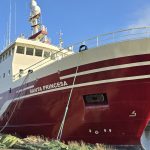Provisional statistics published today by Scotland’s Chief Statistician show a £47 million (12 per cent) increase in the value of fish landed by Scottish vessels in 2009.
The figures show that 378,000 tonnes of fish were landed by Scottish vessels with a value of £443 million.
Landings by Scottish based vessels
Shellfish landings made up 32 per cent by value and 18 per cent by volume of all landings by Scottish-based vessels in 2009, with a total value of £143 million for 69,000 tonnes landed.
Demersal species made up 34 per cent by value and 27 per cent by volume, with a total value of £149 million for 104,000 tonnes landed. This represents an increase of about £10 million (7 per cent) compared with 2008.
Pelagic species made up 34 per cent by value and 54 per cent by volume, with a total value of £151 million for 205,000 tonnes landed. This represents an increase of about £50 million (49 per cent) compared with 2008.
The volume of mackerel landings by Scottish vessels increased by 39 per cent and prices per tonne increased by 12 per cent compared to 2008. Consequently the total value of mackerel landings have increased by 56 per cent to £135 million in 2009. This increase in the value of mackerel landed results in mackerel replacing nephrops as the most valuable species to the Scottish fleet in 2009.
Nephrops are the second most valuable species to the Scottish fleet, with a total value of £77 million. However, as prices per tonne dropped by 15 per cent compared with 2008, this value represents an annual decrease of £14 million from £91 million in 2008.
Between 2008 and 2009 there was a 3 per cent increase in the volume of landings made abroad by Scottish vessels. At an estimated £86 million, the value of all landings abroad by Scottish vessels in 2009 was £33 million (63 per cent) higher than in the previous year. This is due to a doubling of the volume of mackerel landed abroad, obtaining increased prices.
Scottish fishing fleet
The number of active fishing vessels based in Scotland decreased from 2,205 at the end of 2008 to 2,174 at the end of 2009.
Since 2001, the number of over 10m vessels has decreased by 27 per cent, reflecting the impact of two decommissioning schemes in 2001 and 2003 which awarded grants to owners in the Scottish whitefish fleet to decommission their vessel and surrender their fishing licence. The reduction in the number of vessels of all lengths since 2001 is 374 vessels (15 per cent).
The demersal sector has reduced in size steadily since 2001 by a total of 199 vessels (42 per cent). The pelagic sector has also declined by 31 per cent over this period from 36 to 25 vessels, but has grown slightly since 2006 when there were only 21 vessels in the pelagic fleet.
There are currently 1,483 vessels in the under 10m fleet, a net reduction of 121 vessels (8 per cent) since 2001 but only nine fewer vessels than in 2008.
Employment
The number of fishermen employed on Scottish fishing vessels at the end of 2009 stood at 5,409. Although this represents an increase of 1 per cent on the figures for the previous year, the 2009 figures includes over 200 fishermen (4 per cent) associated with a group of vessels which transferred to Ullapool from administration ports in England.Fish Quota Uptake
Uptake of quota was high for the major pelagic fish stocks; approaching 100 per cent for all the four stocks: North Sea Herring, West of Scotland Herring, North Sea Mackerel and West of Scotland Mackerel.
Quota uptake reached 100 per cent for North Sea Plaice and was nearly 100 per cent for seven other key demersal stocks, namely North Sea Cod, West of Scotland Cod, North Sea Haddock, North Sea Whiting, West of Scotland Whiting, North Sea Saithe and West of Scotland Monkfish.
Quota uptake was just over 90 per cent for North Sea Nephrops and just above 60 per cent for West of Scotland Nephrops.








